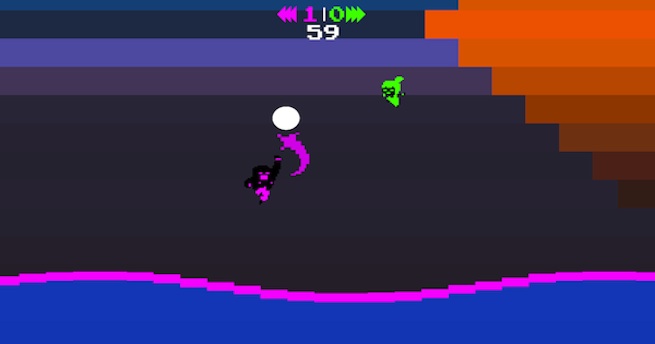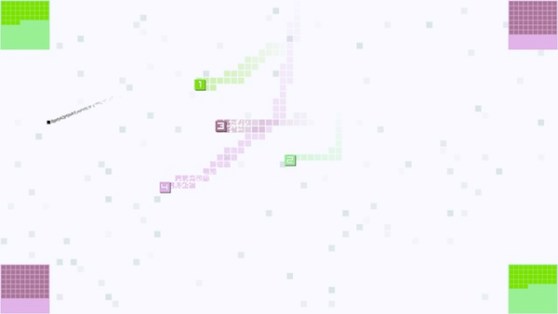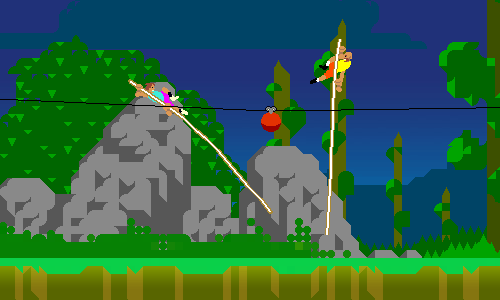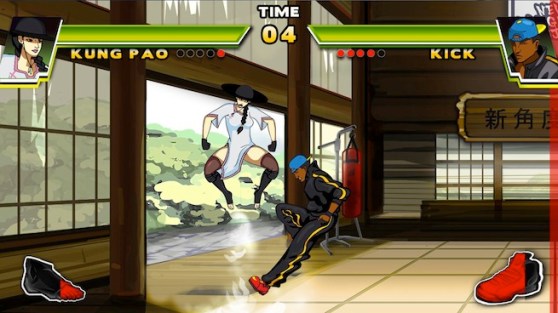SAN FRANCISCO — My opponent inched closer to the TV as the scoreboard updated to 2-2. He immediately grabbed the white ball, but I unleashed a devastating uppercut that knocked it out of his hands. Ten seconds later, we started a new match, our fifth one in just as many minutes. We transformed from curious observers and complete strangers into heated rivals.
Not bad for a PlayStation 3 game that looks like it time-traveled from the 1980s.
Independent developers were the stars of the show at last night’s PlayStation Indie Arcade event during the 2013 Game Developers Conference, where Sony demoed more than two dozen upcoming games for both the PS3 and the PlayStation Vita. Together, they made up an eclectic library that spanned many different genres, but a few had a common thread: local head-to-head multiplayer.
While they may lack the triple-A production values of other competitive experiences — like Street Fighter IV or Madden football — they’re no less exhilarating, especially if you’re the type of gamer who likes to rub your victories in your friends’ faces.
Sportsfriends
Coming out sometime this fall for the PS3, Sportsfriends is actually a compilation of four different games (which the developers successfully crowdfunded using Kickstarter late last year). Sadly, I wasn’t able to play Johann Sebastian Joust — a sort of tagging game that uses PlayStation Move motion controllers timed to music — but here’s a breakdown of the other three (playable with regular controllers):
Hokra
Hokra is kind of like a minimalistic take on soccer, but instead of controlling detailed avatars of real-life players, you’re in charge of brightly colored squares with numbers attached to them. You have to hold and protect the black square in one of your team’s designated goal posts (at the corners of the screen) for as long as you can before the other team rushes in and steals the “ball” by bumping into you.
It’s a game with a simple interface, but that just makes it easy for anyone to pick up and play. You can play against someone 1-on-1, but Hokra is at its best with three other people playing with you. It does not use Move.
BaraBariBall
A weird cross between basketball and dodgeball, BaraBariBall [top] pits one or two-man teams to fight for control over a large white ball. Whoever can launch the ball and sink it into their team’s color-coded goal (a body of water) on the other side of the map scores a point.
As simple as that sounds, it’s actually a little complicated: Others can knock the ball out of your hands with punches and kicks, and you can run out of jumps if you’re not careful (jumping takes up one of the orbs floating around your character, which regenerates when you’re standing on the ground).
Being economical with your movements and playing to your character’s strengths makes BaraBariBall surprisingly deep. Your fortunes can quickly turn around (for good or bad) at the last-second, and each match progressively felt more intense and exciting as we grew used to the controls.
Super Pole Riders
Developer Bennet Foddy takes a second stab at the underserved pole-vaulting genre with Super Pole Riders, a sequel to his physics-based (and browser-only) game. You have to pass a suspended ball to your goal while carrying a large pole. The best way to win is by kicking the ball, but that gets a little tricky since you have to launch yourself off the ground by using the pole, which — as anyone who has played Foddy’s hilarious running game QWOP will know — isn’t an easy feat.
Sometimes I’d completely miss the ball or flip all the way around and kick my opponent instead (it takes a few seconds to respawn). You have to take the physics into consideration, otherwise you’ll just flop around uselessly … but like QWOP before it, that’s half the fun.
Divekick
Without crazy combo moves or complex blocking schemes, Divekick (out this summer as a digital download on the PlayStation Store) may seem like a barebones fighting game. But the creative folks at Iron Galaxy Studios somehow make it feel fierce and dynamic with just two buttons: one to jump and another to kick. Since the kick is your only offensive move, it only takes a single hit to kill someone. Most of the time you’re just trying to lure your opponent close enough to hit them.
Your character is always moving forward, but you can control that distance with character-specific powers (indicated by the sneaker or foot shown below you) that you fill up by kicking. Some can run backward, others can slow their descent after jumping, and another — amusingly named Kung Pao — can summon portals to set traps. It’s a nuanced system that, while ridiculous on the surface, requires the same sort of strategizing and mind games that the bigger franchises are known for.
On the Vita version, two people can play on the same screen with the D-pad and the face buttons, but the best way to play might just be on the PS3. While you can use the regular DualShock controllers, the developers also brought a pair of hefty-looking Divekick “fighting sticks” to the PlayStation event that just had two hand-sized glowing buttons. Instead of the frantic tapping on the Vita, you’re smashing the large buttons as fast as you can.
It’s a little silly — and perhaps somewhat overkill — but the feel and sound (from the constant clicking) of these special controllers perfectly matches the fast-paced combat. However, whether you can buy one for yourself is still up in the air: Iron Galaxy is trying to figure out if it’ll actually sell them.
VentureBeat's mission is to be a digital town square for technical decision-makers to gain knowledge about transformative enterprise technology and transact. Learn More




